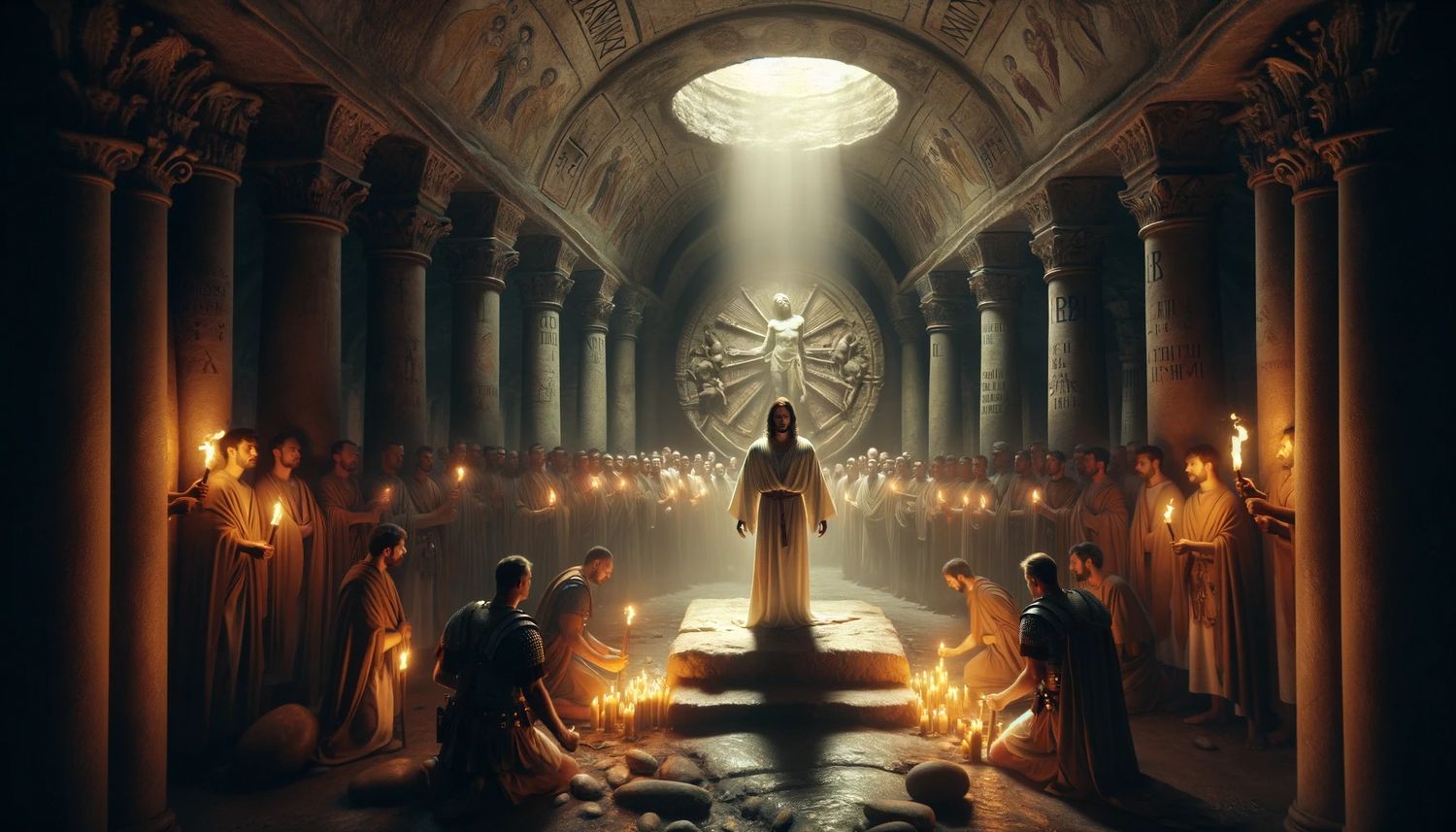Home>Theology and Spirituality>What Is Baptism


Theology and Spirituality
What Is Baptism
Published: March 1, 2024
Jason DeRose, Managing Editor at Christian.net, uses his expertise in religion and journalism to deepen understanding of faith's societal impacts. His editorial leadership, coupled with a strong academic background, enriches the platform’s diverse content, earning him recognition in both journalism and religious circles.
Discover the significance of baptism in theology and spirituality. Explore the meaning and importance of this sacred ritual in Christian faith.
(Many of the links in this article redirect to a specific reviewed product. Your purchase of these products through affiliate links helps to generate commission for Christian.net, at no extra cost. Learn more)
Table of Contents
The Significance of Baptism
Baptism holds significant importance in the Christian faith, symbolizing the cleansing of sin and the initiation into the body of Christ. It is a public declaration of one's faith and a spiritual rebirth, marking the beginning of a new life in Christ. The act of baptism is a profound symbol of the death, burial, and resurrection of Jesus Christ, and by participating in it, individuals identify with His sacrifice and victory over sin and death.
Read more: What Is Baptismal Grace
1. Forgiveness of Sins
Baptism is seen as a means of receiving forgiveness for past sins and entering into a new life of grace. It represents the washing away of sin and the start of a fresh, forgiven life in Christ.
2. Initiation into the Church
Baptism is also a rite of passage into the Christian community. It signifies the individual's incorporation into the body of believers and their commitment to the teachings and fellowship of the church.
3. Symbol of New Life
The act of immersion in water during baptism symbolizes the believer's participation in the death and burial of Jesus Christ, and emerging from the water represents their resurrection to a new life in Him. It is a powerful symbol of spiritual renewal and transformation.
4. Obedience to Christ's Command
For many Christians, baptism is an act of obedience to the command of Jesus, who instructed his followers to baptize in the name of the Father, the Son, and the Holy Spirit. It is a way of publicly acknowledging and affirming one's faith in Christ.
Read more: What Is Baptism In Fire
5. Seal of the Holy Spirit
In some Christian traditions, baptism is believed to be the moment when the Holy Spirit comes upon the individual, marking them as a child of God and empowering them for a life of faith and service.
In summary, baptism holds deep significance in the Christian faith, representing forgiveness, initiation, new life, obedience, and the indwelling of the Holy Spirit. It is a powerful and meaningful sacrament that is central to the identity and practice of many Christian denominations.
The History of Baptism
-
Early Jewish Rituals: The practice of baptism has its roots in ancient Jewish purification rituals, where immersion in water was used to symbolize spiritual cleansing and renewal. This ritual cleansing was often performed before significant religious events or as a means of repentance and forgiveness of sins.
-
John the Baptist: The New Testament records that John the Baptist played a pivotal role in the history of baptism. He is known for baptizing people in the Jordan River as a sign of repentance and preparation for the coming of the Messiah. John's baptism was a call to turn away from sin and to embrace a renewed relationship with God.
-
Baptism in the Early Christian Church: Following the ministry of Jesus Christ, the early Christian church adopted baptism as a central rite. It became a public declaration of faith and a means of initiation into the community of believers. The Book of Acts and the letters of the apostles in the New Testament provide accounts of baptism being practiced as an integral part of the early Christian faith.
-
Development of Baptismal Practices: Over time, various forms of baptism emerged within the Christian tradition. While some early Christian communities practiced immersion in natural bodies of water, others began to use specially constructed baptismal pools within church buildings. The mode and method of baptism varied across different regions and theological traditions.
-
Theological Significance: As the early church developed its theology, baptism became closely linked to the concepts of regeneration, forgiveness of sins, and incorporation into the body of Christ. The writings of early Christian theologians such as Augustine and Origen reflect the growing significance of baptism as a sacrament of spiritual rebirth and initiation.
-
Baptism in the Middle Ages and Beyond: During the Middle Ages, the practice of infant baptism became more widespread, and baptismal liturgies and rituals were further developed within the Roman Catholic and Eastern Orthodox traditions. The Protestant Reformation also brought about diverse perspectives on the theology and practice of baptism, leading to the formation of different denominational views.
-
Contemporary Practices: Today, baptism continues to be a central rite in many Christian traditions, with variations in its theological interpretation and ceremonial practices. While some churches emphasize believer's baptism by immersion, others practice infant baptism or sprinkling. The historical and theological richness of baptism has contributed to its enduring significance within the Christian faith.
Different Views on Baptism
-
Believer's Baptism: This view, held by many Protestant denominations, emphasizes that baptism should be reserved for those who have made a personal profession of faith in Jesus Christ. It is typically administered to individuals who are old enough to understand and express their faith. The mode of baptism is often immersion, symbolizing the believer's identification with the death and resurrection of Christ.
-
Infant Baptism: In contrast, some Christian traditions, such as the Roman Catholic Church and the Eastern Orthodox Church, practice infant baptism. This involves the administration of the sacrament to infants or young children, with the belief that it cleanses them from original sin and initiates them into the community of faith. The mode of baptism may involve pouring or sprinkling water on the child's head.
-
Sprinkling and Pouring: While immersion is the preferred mode of baptism for some, others practice sprinkling or pouring of water as a valid form of the sacrament. This view is often associated with the belief that the mode of baptism is less important than the spiritual significance of the act itself. It allows for flexibility in the administration of the sacrament based on practical considerations and theological interpretation.
-
Symbolic vs. Sacramental: The differing views on baptism also reflect varying understandings of its theological significance. Some Christians view baptism primarily as a symbolic act, representing the believer's inward faith and commitment to Christ. Others hold a sacramental view, believing that baptism is a means of grace through which God imparts spiritual blessings and initiates individuals into the covenant community.
-
Regeneration and Salvation: Another point of divergence is the relationship between baptism and regeneration or salvation. While some traditions teach that baptism is essential for salvation or that it is the moment of spiritual rebirth, others emphasize that salvation is by faith alone and that baptism is an outward sign of an inward reality, without bearing salvific efficacy.
-
Covenantal Theology: Within Reformed and Presbyterian traditions, baptism is often understood within the framework of covenantal theology. It signifies the inclusion of children in the covenant community and the promises of God, drawing parallels to the Old Testament practice of circumcision as a sign of God's covenant with His people.
-
Anabaptist and Radical Reformation Views: Anabaptist groups historically held distinctive views on baptism, advocating for believer's baptism and the voluntary nature of the sacrament. They rejected infant baptism and emphasized the importance of personal faith and commitment before undergoing baptism.
-
Ecumenical Dialogue: In recent years, ecumenical dialogue among Christian traditions has sought to foster understanding and mutual recognition of diverse views on baptism. While differences persist, there is a growing emphasis on the common ground that unites Christians in their belief in the triune God and the significance of baptism as a central rite of the faith.
In summary, the diverse views on baptism within Christianity reflect theological, historical, and ecclesial differences, shaping the practices and beliefs of various denominations and communities of faith.
The Practice of Baptism in Different Christian Denominations
Read more: What Was The Baptism Of John For
Roman Catholic Church
In the Roman Catholic Church, baptism is considered one of the seven sacraments and is typically administered to infants. The sacrament is believed to cleanse the child from original sin and initiate them into the life of the Church. The priest or deacon pours water over the infant's head while invoking the Trinitarian formula, "I baptize you in the name of the Father, and of the Son, and of the Holy Spirit." The Catholic Church also recognizes the validity of baptism by immersion and affusion (pouring), but the normative practice is by affusion.
Eastern Orthodox Church
In the Eastern Orthodox tradition, baptism is also administered to infants and is considered the means of regeneration and entry into the Church. The infant is fully immersed three times in water, symbolizing the death and resurrection of Christ. The priest anoints the child with chrism (holy oil) as a sign of the seal of the gift of the Holy Spirit. The sacrament is followed by the reception of the Eucharist, emphasizing the unity of baptism, chrismation, and Eucharist as the initiation into the life of the Church.
Anglican Communion
Within the Anglican Communion, baptism is practiced in various forms, including infant baptism, believer's baptism by immersion, and affusion. The Book of Common Prayer provides the liturgical framework for baptism, emphasizing the Trinitarian formula and the significance of water as a symbol of cleansing and new life in Christ. The Anglican tradition allows for flexibility in the mode of baptism, accommodating both infant and believer's baptism based on the theological convictions of the individual or family.
Lutheran Church
Lutherans affirm the sacramental nature of baptism and practice both infant and believer's baptism. The sacrament is administered by the pouring or sprinkling of water, accompanied by the Trinitarian formula. Infant baptism is common, signifying God's grace and the child's incorporation into the body of Christ. Believer's baptism by immersion is also practiced in some Lutheran congregations, particularly among those influenced by the Anabaptist tradition.
Read more: What Is Baptism By Sprinkling
Baptist Churches
Baptist churches emphasize believer's baptism by immersion as the normative practice. Baptism is reserved for individuals who have made a personal profession of faith in Jesus Christ. The act of immersion symbolizes the believer's identification with the death, burial, and resurrection of Christ. Baptism is viewed as an ordinance, not a sacrament, and is often conducted in a public setting as a testimony of faith and commitment to Christ.
Pentecostal and Charismatic Churches
In Pentecostal and Charismatic traditions, baptism is seen as a vital step in the believer's spiritual journey. The emphasis is placed on the experience of the Holy Spirit and the empowerment for Christian living. Baptism is often accompanied by the expectation of spiritual gifts and the manifestation of the Holy Spirit's presence in the life of the believer. Both believer's baptism by immersion and affusion are practiced within these traditions.
Reformed and Presbyterian Churches
In Reformed and Presbyterian traditions, baptism is administered to infants as a sign of God's covenant faithfulness and the child's inclusion in the covenant community. The mode of baptism is typically by sprinkling or pouring, reflecting the emphasis on the spiritual significance of the sacrament rather than the mode of administration. Baptism is understood within the context of covenant theology and the promises of God to His people.
Non-Denominational and Independent Churches
Non-denominational and independent churches exhibit a wide range of practices regarding baptism. Some may align with believer's baptism by immersion, while others may practice infant baptism or affusion. The diversity of beliefs and practices within these churches reflects the autonomy and varied theological perspectives present in non-denominational and independent Christian communities.
In summary, the practice of baptism varies across different Christian denominations, reflecting theological convictions, historical traditions, and ecclesial diversity within the broader Christian faith.
Read more: What Are The Requirements For Baptism
The Symbolism of Baptism
-
Cleansing and Purification: Baptism symbolizes the cleansing of sin and spiritual purification. The act of immersion in water represents the washing away of past transgressions and the purification of the soul. It signifies a new beginning and a release from the burden of sin, allowing the individual to start afresh in their spiritual journey.
-
Death and Resurrection: The immersion into the water during baptism symbolizes the believer's identification with the death and burial of Jesus Christ. As the individual is submerged beneath the water, it represents the burial of the old, sinful self. Emerging from the water signifies the believer's resurrection to a new life in Christ, reflecting the transformative power of the Gospel and the hope of eternal life.
-
Union with Christ: Baptism symbolizes the believer's union with Christ in His death, burial, and resurrection. It serves as a powerful visual representation of the believer's spiritual connection to the redemptive work of Jesus. Through baptism, individuals publicly declare their faith in Christ and their desire to be united with Him in His life, death, and victory over sin and death.
-
New Birth and Spiritual Renewal: The act of baptism signifies a spiritual rebirth and the beginning of a new life in Christ. It represents the believer's transition from a life of separation from God to a life of fellowship and communion with Him. The symbolism of water as a source of life and renewal underscores the transformative nature of baptism, marking the start of a journey of spiritual growth and maturity.
-
Community and Fellowship: Baptism also symbolizes the believer's incorporation into the community of faith. It signifies the individual's commitment to the teachings and fellowship of the church, as well as their participation in the larger body of Christ. The act of baptism is a public declaration of one's faith and a recognition of the communal aspect of the Christian journey.
-
Seal of the Holy Spirit: In some Christian traditions, baptism is seen as the moment when the Holy Spirit comes upon the individual, marking them as a child of God and empowering them for a life of faith and service. The symbolism of the Holy Spirit's presence and guidance underscores the transformative and empowering nature of baptism in the life of the believer.
-
Initiation into the Church: Baptism serves as a rite of passage into the Christian community. It signifies the individual's incorporation into the body of believers and their commitment to the teachings and fellowship of the church. The symbolism of initiation underscores the communal aspect of the Christian faith and the importance of belonging to the larger family of God.
In summary, the symbolism of baptism encompasses themes of cleansing, death and resurrection, union with Christ, new birth, community, and the empowering presence of the Holy Spirit. It is a profound and multi-faceted symbol that holds deep significance in the life of the believer and the community of faith.











